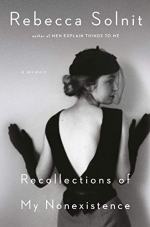|
This section contains 635 words (approx. 2 pages at 400 words per page) |

|
Recollections of My Nonexistence: A Memoir Summary & Study Guide Description
Recollections of My Nonexistence: A Memoir Summary & Study Guide includes comprehensive information and analysis to help you understand the book. This study guide contains the following sections:
This detailed literature summary also contains Topics for Discussion on Recollections of My Nonexistence: A Memoir by Rebecca Solnit.
The following version of this book was used to create the guide: Recollections of My Nonexistence. Solnit, Rebecca. Penguin Random House LLC, 2020.
Rebecca Solnit's memoir, Recollections of My Nonexistence, is written from her first person perspective, and is divided into nine titled sections, each containing smaller numbered chapters. The text subverts linear memoir progressions through time, and frequently envelops a range of other voices and stories within her own.
As a young girl, Solnit grew up in a violent familial setting. Desperate to leave, she found her own apartment in the projects in San Francisco when she was still a teenager. Though the neighborhood was often deemed violent and unsafe, Solnit grew attached to her Lyon Street community. Her apartment was diminutive, but she saw it as a haven, as well as a foundation. The apartment was not a symbol of entrapment, but acted as a gateway to Solnit's coming versions of self.
While living on Lyon Street, Solnit began interrogating the world around her. She was suddenly surrounded by a litany of violent stories, countless women, including herself, threatened, harassed, and violated by aggressive men. Women, she realized, had been taught to be small and silent. Women were meant to be immobile, domestic objects. If women attempted to break out of these strict societal parameters, they were abused, raped, or murdered. These revelations about her gendered limitations, made Solnit increasingly conscious of, and drawn to, other marginalized identities.
Fearful of the world which sought to destroy her body and identity, Solnit retreated into books. She felt a relief living in the imagined and historical worlds of the pages, likening the appearance of an open book to that of a bird in flight. For a time, books granted her the illusion of freedom, the ability to soar above her dangerous world and perceive it without fear from above. However, she soon realized she was not living the life that she wanted. She could not truly be free if she did not learn to find footing in her reality. So she then decided to become a writer.
After her completing her undergraduate degree, she pursued her graduate degree in journalism at UC Berkeley. The academic world proved as inhospitable to her presence and voice as everywhere else. Her personal thoughts, interpretations, and style were discouraged and squashed. The classroom and industry insisted she adopt a hyper-sparing, masculine stance and tone. Solnit resisted, eager to create a new language in which she could express herself, could tell the stories of others like her. In tandem to her studies, Solnit was deepening her interest in the visual arts through her work at the San Francisco Museum of Modern Art. She grew so attached to this artistic world that she began writing about visual artists after grad school. These connections led her to an artistic community in New Mexico, where she established a series of deep and inspiring friendships.
As the years went on, Solnit devoted her life and work as a writer to researching the landscapes and peoples of the West. Her writing fought to make the faces of the invisible visible, to make silenced voices heard and recognized. The books that arose from this work gradually inspired Solnit to begin writing feminist literature. With the encouragement of her closest friends, Solnit published her first true feminist essay: "Men Explain Things to Me." The piece went viral, and initiated a movement in feminist circles and beyond; Solnit's writing inspired countless other women to share their stories. After the publication of this popular and monumental work, Solnit devoted herself more thoroughly to more such writings. She realized that she, along with other women, were starting the change she had always hoped for, fighting to, and succeeding at, interrogating and dismantling the patriarchal structures which limited their freedom.
Read more from the Study Guide
|
This section contains 635 words (approx. 2 pages at 400 words per page) |

|



